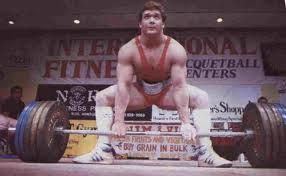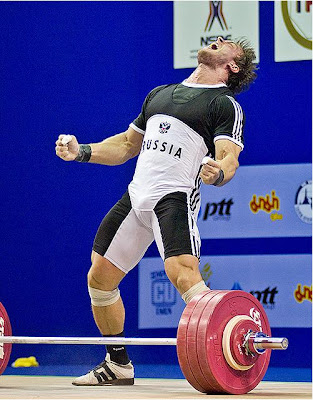To this point in the series, we've established the following:
- high frequency training is hardly the sole purview of steroid-riddled maniacs, but rather a time-tested and formerly very well regarded routine,
- even the fattest and most pathetic people in our society thrive on high-frequency routines
- you're likely not mentally or physically prepared for the rigors of high-frequency training due to your temporal and geographical location in the space-time continuum.
Thus, there's really no reason not to try high frequency training, save for your own time constraints, general unwillingness, or lack of mental preparation. My last two blogs covered the basics of overcoming the myriad mental hurdles you'll likely hit, though, so with a bit of prep and some continual rewatching of Crank 2, you should be ready to fucking crush shit in the gym. Crank 2, you say? Fuck yeah- a frenetically-paced movie about a guy who keeps himself alive by sheer will, all the while engaging in a bit of the ultra-violence and some public sex? Fucking sign me up.
Once you've overcome the mental aspect, you can get cracking on the physical. The average trainee likely spends only four or five hours a week in the gym, separated into as many training sessions. This entry's going to outline two slightly disparate schemes for increasing your total workload, without a lot of extraneous bullshit because I'm pressed for time and I think I've made my point on high-volume.
The first method for increasing volume is that of the Bulgarians, whose system's been studied at great length by Westerners eager to learn the strength training secrets of that impoverished country filled with swarthy He-Men. The method of increasing was outlined in a Critical Bench article, which I've thrown in here for your viewing pleasure.
First, you create a basic full-body routine template:
Monday:
Snatch: 3 singles, using 'Maximum Training Resistance' (use matrix)
Clean & Jerk: MTR matrix
Front Squat: 3 singles, using MTR, then 2 doubles with MTR -15 kilos
Wednesday:
Back Squat: 3 doubles with Monday CJ MTR + 20 kilos
Power Snatch: 3 singles with MTR
Power Clean and Push Jerk: 3 singles with MTR
Romanian Deadlift: 3 triples with Mon CJ MTR + 20 kilos
Friday:
Snatch: work up to true 1RM
CJ: work up to true 1RM
Front Squat or Back Squat: work up to true 1RM
Next, you add a session to the middle day of the week, with the original session conducted in the morning and this one done in the evening.
Snatch 80%/2 (3-4 sets)
CJ 80%/2 (3-4 sets)
Snatch Pulls 3-4 sets of triples with a weight 10 kilos over what was used for the snatches
A couple of months after this, the author of that article suggests you add another day. "What previously would have been the M, W, F workouts, respectively, will now take place on M, Tu, and Sat. What do we add in? On Thursday, you will do a workout that looks exactly like Monday's."
Thereafter, you add another session. See the pattern? "You will add an AM session to Monday. (with the previously done Monday session moved to the PM, or done second)" that looks like this:
Snatch: 85%/2 (3-4 sets)
CJ: 90%/2 (2-3 sets)
Back Squat or RDL to MTR
Step 5: Adding Two Sessions
Last, you add one more session on Thursday you add an AM workout that looks the same as Monday's AM workout, and on Saturday you do the following workout (though it is more of a CNS warm-up than a workout) in the AM:
Back Squat 80%/3 (3 sets)
Power Snatches: 'light'
Power Clean and Push Jerk: 'light'
At that point, you'll be hitting the gym 8 times a week, breaking your ass "just like the Bulgarians." As I've explained, the Bulgarians train a fuckload more than that, but insofar as this article and anyone with a fulltime job are concerned, this is how you're going to get it done, step by step, in paint-by-numbers format. In case you're curious about how those wacky little Eastern Europeans work their loading protocols, I found the following explanation, which is pretty interesting:
Bulgarian lifters go for their daily max at every 2 sessions. However that daily max is not necessarily a personal best attempt, rather it's a load that is very challenging for that day. In most cases, it equates to 85-95% of their competitive max. In their "heavy" sessions Bulgarian lifters will build up to their daily max. This max is not an end in itself, rather it is the starting point of their training: the daily max is used to calculate the training load for the rest of the day. Once a lifter reaches his max, he backs down 25-40lbs and do 3-5 sets of 2-3 reps. That are the money sets! With this form of training your daily session is always adapted to your present capacities. Bulgarian wave loading parameters Sets 1 - 3: Warm-ups with a load lower than 60% of the competition max/personal record Sets 4 - 7: Work up to the daily 1 rep maximum Sets 8-9: Daily max - 40lbs for 3 reps Sets 10-12: Daily max - 25lbs for 2 reps They will use this form of loading for 3 daily exercises. On "lighter" days they will do technique work with a relatively light load (60-70%). They will not have a precise number of sets to do. They do 3 different exercises, allocating 15-20 minutes per exercise and they do however sets they feel comfortable doing that day."
With a little imagination, you can adapt this template to any couple of lifts at which you want to get fucking good, and you will. I think if you're applying it to powerlifting, you'd likely want to consider making the second daily session a speed session, so as to prevent an aneurysm or other unforeseen catastrophe. If you want to give the above loading protocols a shot, however, and email me the results, I'd be fascinated to find out what the result was.

Even powerlifting, although powerlifters will claim that it's impossible and you'll get cancer of the AIDS.
If you want something a little less rigid, a little more fun, and certainly less orthodox, you can try my methodology for adding workouts. It is hardly scientific, and although I'll explain what I do (more or less) in this blog, I've actually got an upcoming blog that will outline my reasoning and basic AM workouts in greater detail.
I don't care if she wants something less rigid, because rigid's all she's fucking getting.
For now, I can tell you that when I started increasing my volume to increase my workload, I designated my AM workouts as primarily light workouts. Thus, I started by going Monday, Wednesday, and Friday for 20 minute workouts that consisted of either reasonably light machine work (yup, machines!), dumbbell work,
bodyweight exercises, or light barbell work with a focus on form. At that point, I stopped (for the most part) doing light workouts in the evening, and but truncated some of my heavy workouts to balance the load. Thereafter, I added two more AM workouts after a couple of weeks, and generally stick to a volume of 3-5 AM workouts and 6 evening workouts, for a total of no less than 8 total workouts a week. I self-regulate my volume based on time constraints and how I feel, so the following is hardly a set routine- it's more like a sweeping generalization than a program. My AM workouts range from 15 to 45 minutes, and my evening workouts range from 30-90 minutes, depending on aforementioned factors. I posted a basic outline of my workouts in
this blog, and though my routine varies widely, that's a pretty accurate depiction of what it generally looks like. Should I find that I'm in a tremendous amount of pain, or if I find my lifts falling off, I'll back off a bit to allow myself to recover, though I'm still in the gym 6-8 times a week on the
backoff weeks.

It's a journey that will hopefully include co-ed naked rockclimbing sometime soon.
The key to my strategy is that my program is supposed to be a journey, rather than a destination. I constant tinker with my loading, my exercise selection, the workout frequency, and every other parameter of which I can think. The purpose for this is two-fold: I have no set goals in mind, and I want to continue enjoying my twice-daily trips to the gym, rather than dreading them for their monotony.
Like I stated in the last installment of this series- this isn't fucking rocket surgery. The biggest bitch of the entire thing is dragging your ass out of bed in the morning and getting to the gym. Once you're there, the weights practically lift themselves. Thus, if you want to start adding volume, step one is setting the alarm, what you do once you get to the gym matters less than the fact that you're actually there- get there first, and figure it out from there.
Ding Dong motherfucker! Now, go set your alarm.
Sources:















































